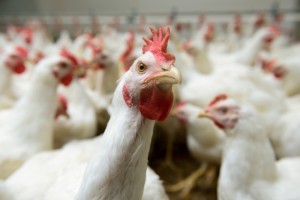The Centers for Disease Control (CDC) and the World Health Organization (WHO) have called for an end to the nontherapeutic use of drugs in animals that are used to treat human disease. Why? The short answer is giving healthy livestock these drugs breeds superbugs that can infect people.
Here’s a great explanation from the Union of Concerned Scientists: “Bacteria become resistant to antibiotics through overexposure to them. Hardy strains of the bacteria survive the exposure and pass on that resistance trait to successive generations. And they also pass the trait across to other bacteria that are unrelated, including some that cause human disease. Eventually the antibiotic wipes out all the vulnerable bacteria, and only resistant bacteria remain. Then the drug is no longer effective.”
The U.S. Food and Drug Administration (FDA) started testing retail meat and poultry for antibiotic-resistant bacteria in 1996. It was not until 2008, however, that Congress required companies to report the quantity of antibiotics they sold for use in agriculture to the FDA. Why is that so important? According to a report from the New York Times, “In 2011, drugmakers sold nearly 30 million pounds of antibiotics for livestock — the largest amount yet recorded and about 80 percent of all reported antibiotic sales that year. The rest was for human health care.”
That’s right, 80 percent of antibiotics are being used for livestock! That means the meat and poultry we humans eat give resistant bacteria a direct route to us — right through the grocery store and into our kitchens. But combating resistance requires monitoring both the prevalence of antibiotic-resistant bacteria in our food, as well as the use of antibiotics on livestock.
In March of this year, McDonald’s announced a plan to require chicken suppliers to stop using antibiotics important to human medicine within two years. Chicken supplier Tyson Inc. reported they’ll also stop giving chickens the same antibiotics used by humans; Tyson noted it has reduced the use of antibiotics effective in humans by more than 84 percent since 2011. The National Chicken Council also released a statement that says chicken producers have been working to phase out the use of antibiotics important in human medicine to promote growth in animals.
Restaurant chains Chipotle and Panera already say they serve chicken raised without antibiotics, but the announcement by McDonald’s is notable because of its size. McDonald’s has more than than 35,000 locations on Earth, and the U.S. has the highest concentration of them — about one for every 20,000 residents according to The Guardian’s Datablog. Compare that to Chipotle’s nearly 1,800 U.S. locations and Panera’s almost 1,900 U.S. locations.
There is more than enough scientific evidence to justify curbing the rampant use of antibiotics for livestock, yet the food and drug industries are fighting proposed legislation to reduce these practices. What do you think about antibiotic use in agriculture and livestock? Should they all move to using drugs that are not considered medically important for humans? Share your insights now in the comments section.

